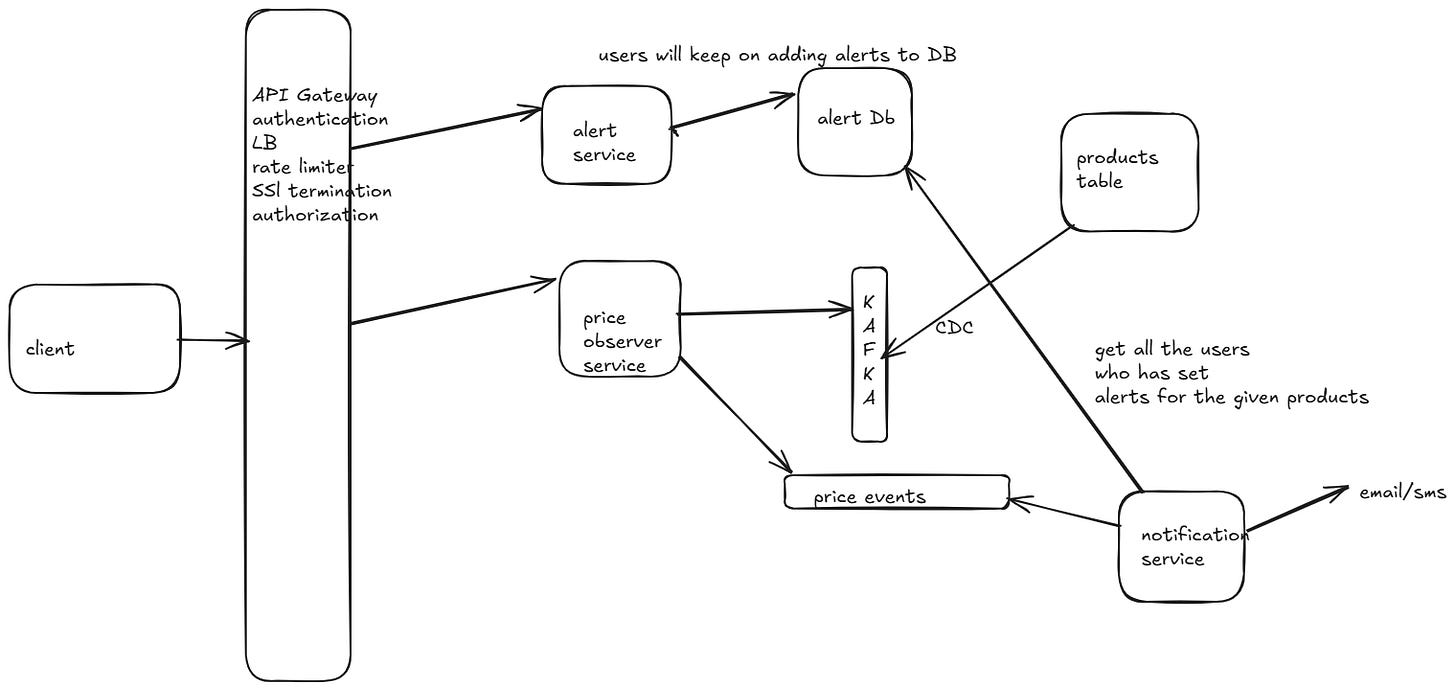Design price alert system for Amazon
Designing a Price Alert System for Amazon involves building a system that allows users to get notified when the price of a product drops to or below a specified threshold.
FR
1.Users can create price alerts for products.
2.Users can update or delete existing alerts.
3.System continuously monitors price changes of tracked products.
4.Price updates are fetched from the Amazon product catalog or frontend APIs.
5.When the product price drops to or below the user-specified target price,notify users abt it
6.Limit the number of alerts a user can set.
7.Avoid sending the same alert multiple times if the price is unchanged.
8.Users can view the list of all active alerts.
NFR
1.The system should be highly scalable to support millions of users and tens of millions of alerts.
2.Notification latency should be minimal — alerts should be sent within a few seconds of detecting a price drop.
3.High availability (99.99%) is required for a consumer-facing service
4.System should be fault tolerant. The system should be resilient to failures of individual services or components.
5.Strong consistency isn't critical, but eventual consistency is acceptable for price data.
Estimates
Active users: 50 million
Avg alerts/user: 5
Total alerts: 250 million
QPS=250M/10^5(86400 approx)=250*10^6/10^5= 2500 QPS=2.5K QPS
Tracked products: 100 million (subset from Amazon catalog)
Alert check frequency: every 10 minutes
Avg notification size: 1 KB
10% of alerts get triggered per day
ach alert stores:
user_id (16 B)
product_id (16 B)
target_price (4 B)
notification_type (e.g., push/email) (8 B)
timestamp (8 B)
metadata (20 B)
Total ≈ 72 B per alert
Storage for 250M alerts =
250M * 72 B ≈ 18 GB
Add metadata, indexes, redundancy → round up to ~50 GBAPI’s
1.POST /api/v1/alerts
request {
"product_id": "B08XYZ1234",
"target_price": 499.99,
"notification_type": "email",
"currency": "USD"
}
response {
"alert_id": "a1b2c3d4",
"message": "Alert created successfully"
}
2.GET /api/v1/alerts
response [
{
"alert_id": "a1b2c3d4",
"product_id": "B08XYZ1234",
"target_price": 499.99,
"current_price": 525.00,
"notification_type": "email",
"is_active": true,
"created_at": "2025-04-24T10:00:00Z"
}
]
3.PUT /api/v1/alerts/{alert_id}
request {
"target_price": 459.00,
"notification_type": "push"
}
response {
"message": "Alert updated successfully"
}
4.DELETE /api/v1/alerts/{alert_id}
{
"message": "Alert deleted successfully"
}
5.PATCH /api/v1/alerts/{alert_id}/status
request {
"is_active": false
}
response {
"message": "Alert status updated"
}
6.GET /api/v1/alerts/history
response [
{
"alert_id": "a1b2c3d4",
"product_id": "B08XYZ1234",
"triggered_price": 479.99,
"triggered_at": "2025-04-22T08:32:00Z",
"notification_type": "email"
}
]
GET /api/v1/user/notifications
POST /api/v1/user/notifications
Databases
🗄️ Database Choice
We’ll use a hybrid approach:
1. Relational DB (e.g., PostgreSQL / MySQL)
For storing alerts, users, and notification preferences
ACID transactions help with data integrity
2. NoSQL (e.g., DynamoDB / Redis / MongoDB) — optional
For fast price lookups or caching product metadata
Redis could also help with deduping notifications, alert queues
🧩 Relational DB Schema
📍 users table
CREATE TABLE users (
user_id UUID PRIMARY KEY,
email VARCHAR(255) NOT NULL UNIQUE,
name VARCHAR(100),
created_at TIMESTAMP DEFAULT CURRENT_TIMESTAMP
);
🔔 price_alerts table
CREATE TABLE price_alerts (
alert_id UUID PRIMARY KEY,
user_id UUID REFERENCES users(user_id),
product_id VARCHAR(50),
target_price DECIMAL(10, 2),
currency VARCHAR(5),
notification_type VARCHAR(20), -- e.g., email, push
is_active BOOLEAN DEFAULT TRUE,
created_at TIMESTAMP DEFAULT CURRENT_TIMESTAMP
);
💰 products table (Optional - for price caching)
CREATE TABLE products (
product_id VARCHAR(50) PRIMARY KEY,
title TEXT,
current_price DECIMAL(10, 2),
currency VARCHAR(5),
last_checked TIMESTAMP
);
📨 triggered_alerts table (for history/logs)
CREATE TABLE triggered_alerts (
id BIGSERIAL PRIMARY KEY,
alert_id UUID REFERENCES price_alerts(alert_id),
user_id UUID REFERENCES users(user_id),
product_id VARCHAR(50),
triggered_price DECIMAL(10, 2),
triggered_at TIMESTAMP,
notification_type VARCHAR(20)
);
⚙️ user_preferences
CREATE TABLE user_preferences (
user_id UUID PRIMARY KEY REFERENCES users(user_id),
default_currency VARCHAR(5),
default_notification_type VARCHAR(20),
timezone VARCHAR(50),
language VARCHAR(10)
);
🔄 Optimization & Indexing Suggestions
Index
product_id,is_active, andtarget_priceinprice_alertsfor fast price evaluations.Use materialized views or caching layer (Redis) for price-to-alert mapping if needed.
Background job workers can periodically:
Fetch prices
Match against alerts
Send notifications
Store in
triggered_alerts
HLD



Good job in providing lot's of details for the system design. Only thing I wanted to recommend to work more on explaining about the HLD diagram and it's services in more details for clarity